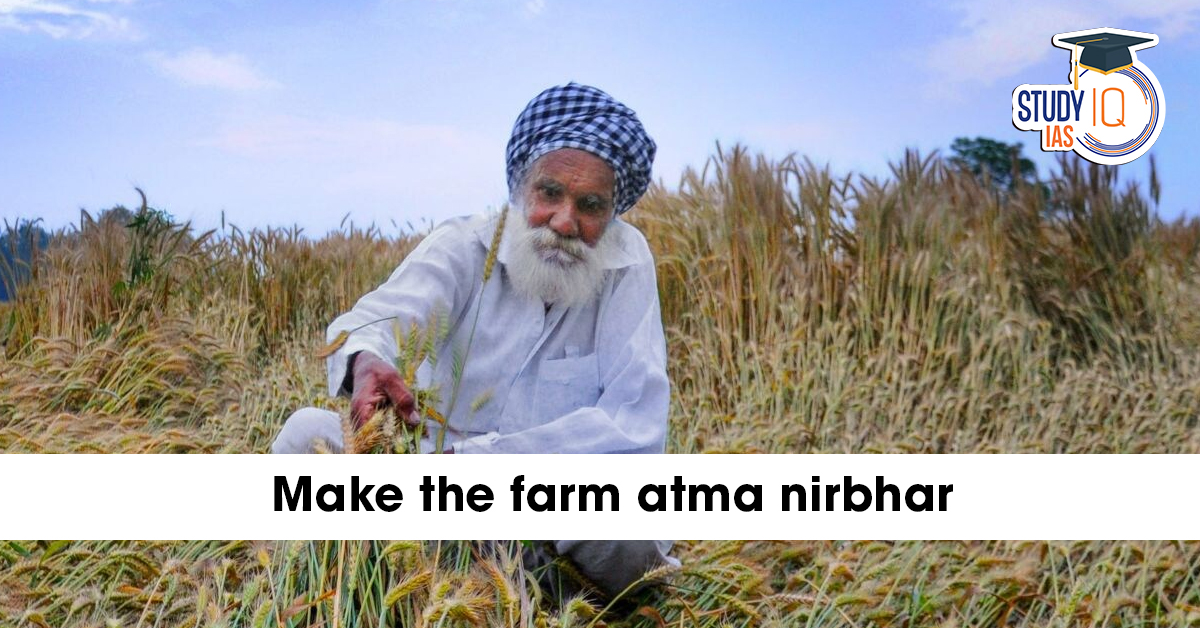Table of Contents
As India observed World Food Day 2025 under the theme “Hand in Hand for Better Food and a Better Future,” the focus turned towards regenerative agriculture — a transformative approach that restores soil health, strengthens biodiversity, and ensures nutritional security.
The article “Make the Farm Atmanirbhar” by Ashok Gulati and Ritika Juneja emphasizes that self-sufficiency in pulses and oilseeds is not just about reducing imports but also about healing soils, conserving groundwater, and curbing pollution.
What is Regenerative Agriculture?
Regenerative agriculture goes beyond sustainability — it actively improves the ecosystem. It focuses on:
-
Increasing Soil Organic Carbon (SOC) levels.
-
Enhancing biodiversity and crop diversity.
-
Reducing chemical dependence on fertilisers and pesticides.
-
Strengthening climate resilience in farming.
India’s average SOC level stands below 0.3%, far below the optimal 1%, leading to poor soil health and lower productivity, particularly in Punjab, Haryana, and Rajasthan.
Mission for Aatmanirbharta in Pulses (2025–26 to 2030–31)
To promote self-reliance and reduce import dependency, the Government of India has launched the ₹11,440 crore “Mission for Aatmanirbharta in Pulses.”
Key Objectives:
-
Scale up domestic pulse production to 350 lakh tonnes.
-
Encourage nutrient-rich and low-input crops like pulses and oilseeds.
-
Promote soil nitrogen fixation naturally, reducing fertiliser use.
-
Achieve nutritional and agricultural self-sufficiency by 2031.
This mission marks a crucial step toward regenerative, climate-smart agriculture.
The 4 Ps of Agricultural Transformation
The authors highlight that India’s path to Atmanirbhar Krishi depends on the synergy of 4 Ps — Policies, Products, Practices, and Partnerships.
1. Policies:
Implement crop-neutral incentives ensuring pulses and oilseeds receive the same policy and market support as rice and wheat.
2. Products:
Focus on developing high-yielding, climate-resilient varieties through R&D and biotechnology.
3. Practices:
Encourage sustainable farming methods such as crop rotation, precision farming, and water-efficient irrigation.
4. Partnerships:
Foster collaboration between government, private sector, and global research institutions to scale innovation.
The launch of the Global AgXelerate Platform by AgVaya, BioSTL, and ICRIER exemplifies how international collaboration can promote agri-innovation and farmer empowerment.
Lessons from the Past: From Green Revolution to Regenerative Revolution
India’s Green Revolution transformed it from a food-deficient nation in the 1960s to a major rice exporter today. However, the heavy use of synthetic fertilisers and water-intensive crops led to new environmental challenges — soil degradation, groundwater depletion, and air pollution from stubble burning.
Now, India must transition from “Food Security” to “Nutritional and Ecological Security.”
Why Self-Sufficiency in Pulses and Oilseeds Matters
Achieving Atmanirbharta in these crops can create a multi-dimensional impact:
| Aspect | Impact |
|---|---|
| Nutrition | Improves protein intake and food diversity |
| Soil Health | Pulses fix nitrogen naturally, restoring fertility |
| Water Conservation | Requires less irrigation compared to rice/wheat |
| Climate Benefits | Cuts GHG emissions and reduces stubble burning |
| Economic Stability | Reduces import bills and supports farmer income |
The Road Ahead
To truly “make the farm Atmanirbhar,” India needs to:
-
Reform Minimum Support Price (MSP) and procurement systems.
-
Invest in agri-R&D and soil health rejuvenation.
-
Encourage value-chain development for pulses and oilseeds.
-
Integrate digital innovation for better farm management.
-
Support farmers through training, incentives, and cooperatives.
Conclusion
The vision of Atmanirbhar Krishi is not just about food self-sufficiency — it’s about nourishing people while regenerating the planet.
By prioritising pulses, oilseeds, and regenerative agriculture, India can ensure:
-
Nutritional security for its population,
-
Ecological balance for its lands, and
-
Sustainable livelihoods for its farmers.
In the words of Gulati and Juneja, achieving self-sufficiency in these crops will “heal soils, conserve groundwater, save air from pollution, and promote biodiversity.”
It’s time to make Indian agriculture truly Atmanirbhar and regenerative.


 Municipal Bonds in India: Meaning, Featu...
Municipal Bonds in India: Meaning, Featu...
 Cyclone Montha 2025: Severe Storm Batter...
Cyclone Montha 2025: Severe Storm Batter...
 Kafala System: Meaning, History, Issues,...
Kafala System: Meaning, History, Issues,...




















